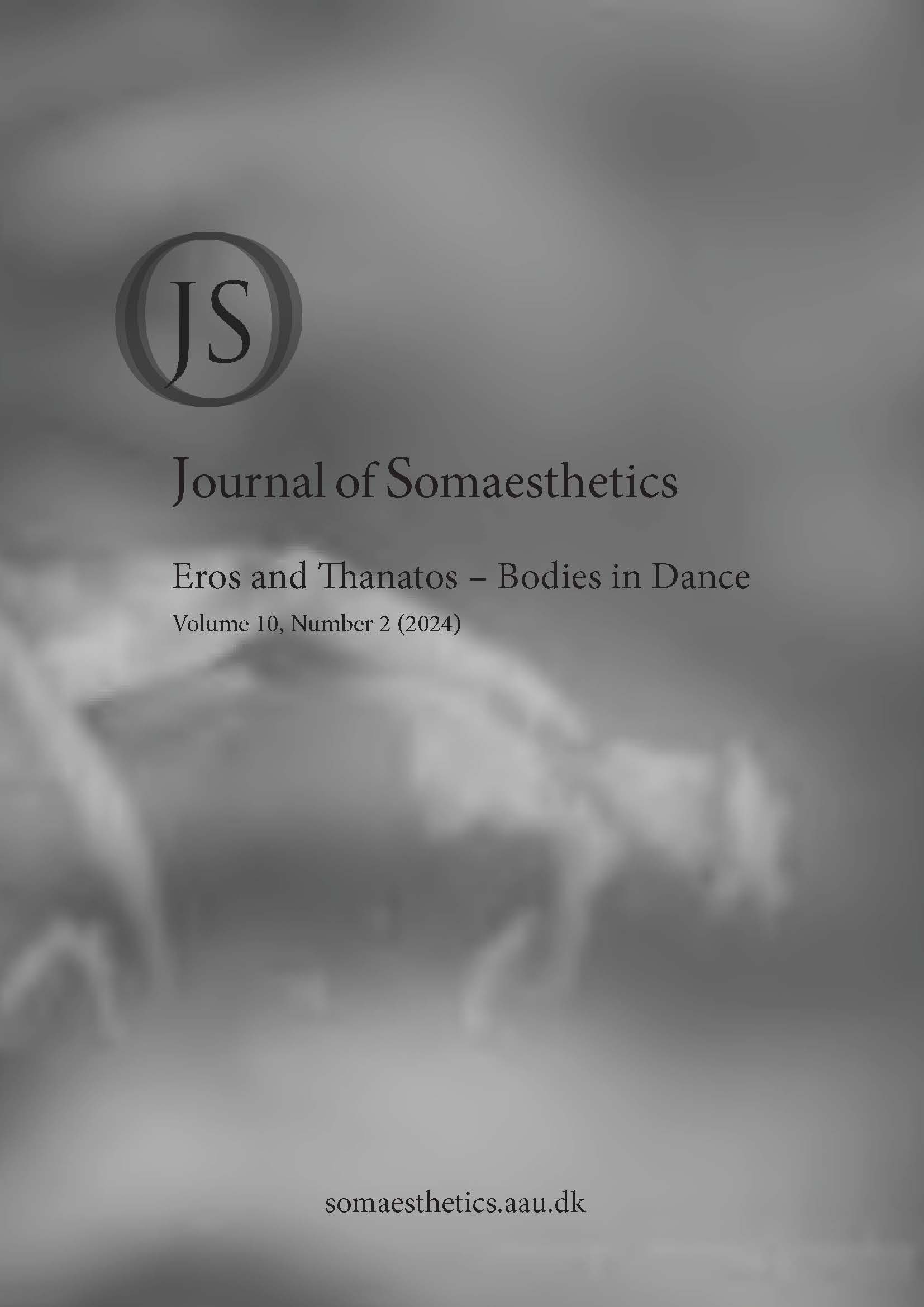Butterflies in the Flames
Romantic Ballet and the Spectacle of the Burning Ballerina
DOI:
https://doi.org/10.54337/ojs.jos.v10i2.8595Abstract
Some of Romantic ballet’s best-remembered dancers are those who burned to death in horrific stage accidents. Emma Livry, the rising hope for the French ballet, was scorched during a rehearsal when her costume caught fire, lingering in a state of perpetual agony for eight months before dying of infection. In the United States, four sisters dancing together at Philadelphia’s Continental Theatre, as well as a number of other dancers, perished when their dressing room went up in flames.
The remarkable phenomenon of the burning ballerina spurred public outcry against unsafe conditions for dancers, and yet as a grisly form of visual spectacle, the image of the dancer-aflame both disturbed and excited those who watched and wrote of it. The English ballerina Clara Webster died during a performance of The Revolt of the Harem, inspiring author and influential early ballet critic Théophile Gautier to include a fictionalized version of her death in one of his novels. Using the histories of several nineteenth-century ballerinas who burned in stage accidents as its focal point, this article will examine how the figure of the burning ballerina is rendered—immortally—as a dual emblem of hyper-ability and disability, living virtuoso and dead angel of the dance. Onstage, her body, dancing on the brink of destruction, generates a powerful affective miasma that is perceptible to the spectator; on the page, she metamorphoses beneath the weight of the competing aesthetic configurations that ballet writers impose upon the narrative of her death, configurations of pious disembodiment and agonizing ‘hyper’-embodiment (in which the body is made to carry not only the weight of its own visceral matter, but also the weight of aesthetic figuration).
This article will discuss the frightening delights of looking at—and writing about—another body as it is on the cusp of decay, death, and dissolution, even at the height of its aesthetic perfection. All the while, this body possesses a powerful and moving affect of its own, never exhaustible, never fully recoverable, but always inviting us to look again.
References
Anonymous (1861, September 16). The death-bed of a ballet girl. The Adams Sentinel, 1. Gettysburg Adams Sentinel Newspaper Archives. https://access-newspaperarchive-com.ezaccess.libraries.psu.edu/us/pennsylvania/gettysburg/gettysburg-adams-sentinel/1861/09-16/
Anonymous (1868). The holocaust of ballet-girls. The Lancet, 91(2333), 631-2.
Anonymous (1861, October 1). “The recent terrible accident at the Continental Theatre in Philadelphia.” Richmond Daily Dispatch. Boatwright Memorial Library. https://dispatch.richmond.edu/view/secondary-section-view.php?doc=D_020_076&q=ballet&start=1&num=10&div=article&dn=11
Biss, E. (2007). The pain scale. Creative Nonfiction, 32, 65–84. http://www.jstor.org/stable/44363570
Caruth, C. (1991). Unclaimed experience: trauma and the possibility of history. Yale French Studies, 79, 181–92. https://doi.org/10.2307/2930251
D’Ambert, P. (1863). Emma Livry. Le nain jaune: journal politique, littéraire et financier, 23, 1-3. https://gallica.bnf.fr/ark:/12148/bd6t596347r/f1.item.zoom#
De Man, P. (1984). Shelley disfigured. The rhetoric of romanticism (pp. 93-123). Columbia UP.
Derrida, J. et al. (1984). No apocalypse, not now (full speed ahead, seven missiles, seven missives). Diacritics, 14(2), 20–31. https://doi.org/10.2307/464756
Duncan, I. (1969). The dance of the future. In S. Cheney (Ed.), The art of the dance (pp. 54-63). Theatre Arts Books, 1969.
Duyckinck, E. A. (1845). Barbarities of the theatre. Broadway Journal, 1(5), 71-2. https://broadway.dsl.lsu.edu/#/issues/18450201/p5?viewer=pdf&page=5
Fire at the ballet, Continental Theater, Philadelphia, September 14, 1861 [detail]. (1861, September 28). Frank Leslie’s Illustrated Newspaper, 312-313. House Divided: The Civil War Research Engine at Dickinson College, https://hd.housedivided.dickinson.edu/node/33093
Frightful scene in the dressing-room of the Continental Theatre, Philadelphia, on the evening of Saturday, September 14, 1861—Accidental burning of a portion of the ballet corps while preparing for the dance in Shakespeare’s play of the “Tempest,” resulting in the death of seven of the dancers.—Sketched by Mr. Oehlschlager, who witnessed the catastrophe [detail]. (1861, September 28). Frank Leslie’s Illustrated Newspaper, 312-3. Nineteenth Century U.S. Newspapers, https://link-gale-com.ezaccess.libraries.psu.edu/apps/doc/GT3012566957/NCNP?u=psucic&sid=bookmark-NCNP&xid=197e902c
Gautier, T. (1986). Opéra: Aelia et Mysis. In I. Guest (Trans. & Ed.), Gautier on dance (pp. 250-6). Dance Books (Original work published 1853).
Guest, I. (1953). The ballet of the second empire: 1858 – 1870. A. & C. Black.
Kelly, D. (2014). Ballerina: Sex, scandal, and suffering behind the symbol of perfection. Greystone Books.
Michael, Y., and Shaukat, N. M. (2023). Erysipelas. StatPearls via NCBI. https://www.ncbi.nlm.nih.gov/books/NBK532247/
Radcliffe, A. (2001). The mysteries of Udolpho. In Parentheses. (Original work published 1794).
Shaw, E. M. (1876). Fires in theatres. E. and F. N. Spon.
Shusterman, R. (1999). Somaesthetics: A disciplinary proposal. The Journal of Aesthetics and Art Criticism, 57(3), 299-313.
Shusterman, R. (2012). Thinking through the body: Essays in somaesthetics. Cambridge University Press.
Swift, M. G. (1982). Dancers in flames. Dance Chronicle, 5(1), 1-10. Taylor & Francis, Ltd. http://www.jstor.org/stable/1567482
Downloads
Published
Issue
Section
License
Copyright (c) 2024 Kathryn Boyer

This work is licensed under a Creative Commons Attribution-NonCommercial-NoDerivatives 4.0 International License.
Articles published in The Journal of Somaesthetics are following the license Creative Commons Attribution-NonCommercial-NoDerivs 4.0 Unported (CC BY-NC-ND 4.0). Authors retain copyright and grant the journal right of first publication with the work simultaneously licensed under a Creative Commons Attribution License: Attribution - NonCommercial - NoDerivs (by-nc-nd). Further information about Creative Commons
If excerpts, tables, figures, charts, artwork or photographs from other copyrighted works are included in an article, it is the author’s responsibility to obtain written permission from the copyright owners and credit the source’s in the article and citation list.


